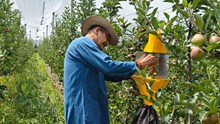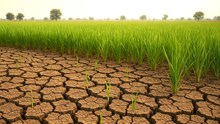
In the far reaches of the North Eastern states and mountainous areas of Uttarakhand and Himachal Pradesh, an ancient herb silently grows in backyard gardens, jhum lands, and forest boundaries. It is locally referred to by various names such as Thoiding in Manipur, Silam in Sikkim, Chhawhchi in Mizoram, and Bhangjira in Hindi-speaking areas. This crop is none other than Perilla botanically known as Perilla frutescens. It is long used in chutneys, pickles, and medicine and has long been a source of sustenance for households.
Though few farmers know that this common crop could also bring new opportunities in edible oil, health supplements, cosmetics, and even production of paint and ink. As demand for plant-based omega-3 oils and natural products increases worldwide, perilla is now being considered as a hidden treasure of Indian hill farming.
Perilla is a self-pollinating, bushy, fragrant, herbaceous shrub that grows well in hilly lands and rainfed soils. It exists in two principal types- Perilla frutescens var. frutescens, which is cultivated for oilseed production, and P. frutescens var. crispa, which is used for medicinal and culinary purposes.
Perilla seeds have 35–50% oil content and are dense in alpha-linolenic acid (ALA), a vital omega-3 fatty acid essential for the heart and brain. Besides being a healthy oil, perilla oil finds applications in paint, varnish, and ink production, and hence it is an edible as well as industrial crop.
Suitable Crop for Hills: Climate, Soil and Season
Perilla is suited to the agro-climatic conditions of the North Eastern Hill Region (NEHR), Uttarakhand's Kumaon and Garhwal, and some areas of Himachal Pradesh. It thrives in cool temperatures and flourishes well in well-drained fertile soils. In Manipur and in the surrounding regions, sowing is typically done from March to May, and the harvesting is carried out from September to December.
The crop takes around 5 to 6 months to mature and does particularly well in jhum (shifting) cultivation or even in kitchen gardens. Genotypes of medium duration are suggested for early harvests, particularly in rainfed conditions.
Sowing Methods and Seed Maintenance
Perilla seeds can be sown by farmers in seed drills or in conventional ploughing. Seeds are to be planted at a depth of 3 to 4 cm and well covered for protection against bird damage. Line sowing with 50 cm row and 30 cm plant-to-plant spacing produces the best yields. Trichoderma viride at a concentration of 6 g per kg of seed is very effective for treating seeds to guard against soil-borne infections. Seeding rate varies with method which is 5 to 6 kg/ha for line sowing, and approximately 10 kg for broadcasting.
Nutrient and Organic Fertilizer Management
Perilla is sensitive to organic and biological matter. During the last ploughing, around 10 tonnes of FYM that has been well-rotted or compost should be added to the field. For better nutrient absorption and growth, biofertilizers like Azospirillum and Pseudomonas (10 kg/ha each) can be used.
Perilla also gets the benefits of furrow liming (500 kg/ha) and suggested rates of chemical fertilizers like 60:40:40 kg/ha of N:P:K. Organic farmers may also employ the use of 2 tonnes of vermicompost, biofertilizers, and mycorrhiza for soil fertility and yield promotion.
Weed, Water and Crop Health Management
Weeding at least twice in the first 60 days of sowing. Light earthing-up or manual hoeing will be sufficient. Perilla being a robust plant requires little watering, yet one or two irrigations at branching and pre-flowering phases would enhance yield considerably. Waterlogging should be avoided. Drip irrigation is recommended in row-sown land, particularly during drought.
Aphids are one of the most universal pests that infest perilla. They are leaf and flower feeders, and they lead to yellowing and stunted growth. Organic methods such as neem oil spray or releasing natural enemies such as ladybird beetles, lacewings, and hoverflies can be very effective. On extreme infestation, suggested insecticides such as Thiamethoxam can be applied within tolerable limits. For Bihar hairy caterpillar, mechanical removal, trap crops such as castor, and biological sprays such as Beauveria bassiana are recommended.
Harvesting and Post-Harvest Management
The harvest of perilla is best done when the seed heads are mature, typically in the afternoon. Inflorescences are harvested and kept in gunny bags. As perilla is a self-pollinating crop, it is simple to save seeds. For seed production, the early harvests should not be disturbed in order to provide genetic purity. Off-type plants must be culled during flowering and seed formation phases. Seeds harvested should be well-dried to 8% moisture content and placed in airtight storage in cool, dry locations.
Perilla is more than a folk herb, it is a sustainable crop with vast nutritional and economic potential. For hill and tribal farmers, it provides a low-input, high-value alternative that accommodates well with diversified and organic farming systems. It enhances diets, promotes health, and provides an opening to niche markets for oils, health supplements, and even industrial applications. With improved awareness, scientific guidance, and local seed support, perilla can become an important contributor to improving hill agriculture and farmer livelihoods in some of India's remotest yet richest regions.
















